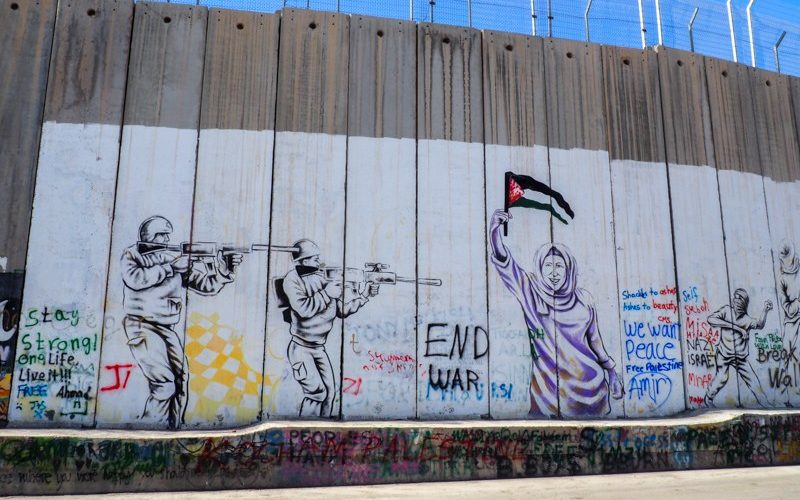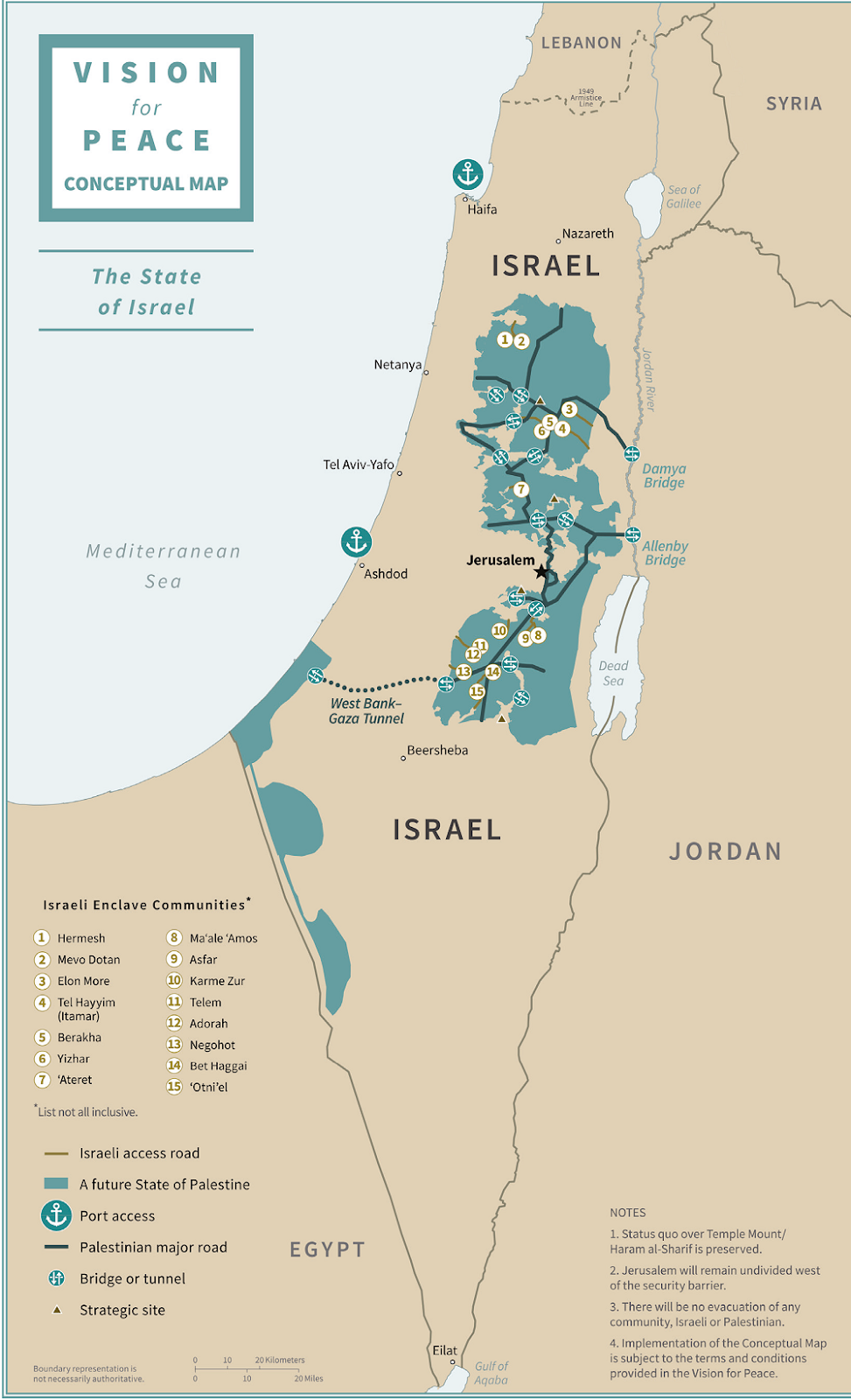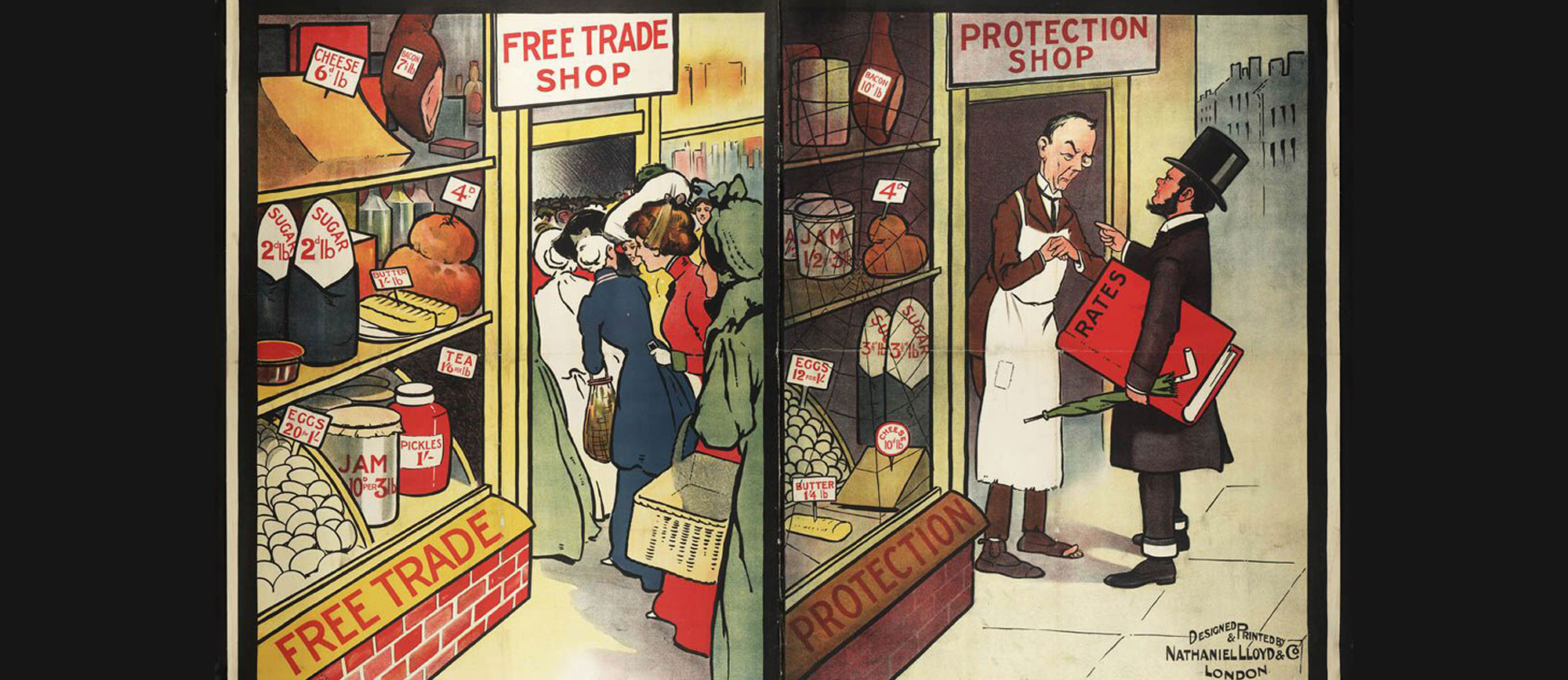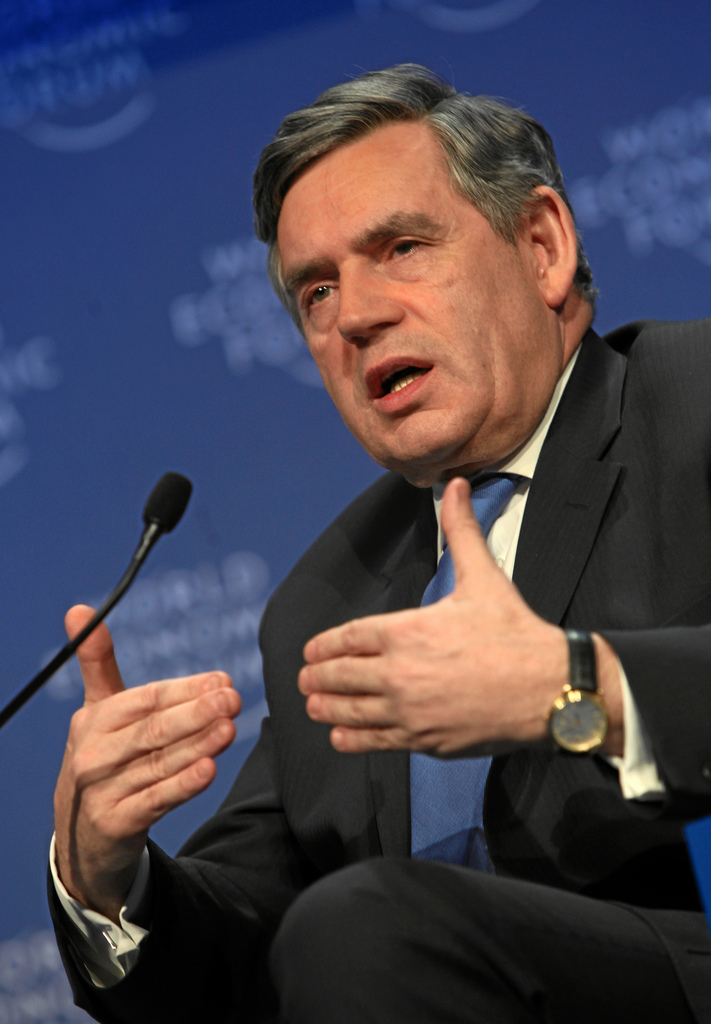In late January of this year, US President Donald Trump and Israeli Prime Minister Benjamin Netanyahu formally unveiled “Peace to Prosperity,” a proposal by the Trump administration to resolve the Arab–Israeli conflict. The so-called “Deal of the Century” plagiarizes a forty-year-old plan by the World Zionist Organization, envisions a disjointed Palestinian state, and loosely promises meager benefits to Palestinians, contingent on “fantastic conditions.” It pays lip service to an outdated concept—the two-state solution. For how could such a proposal truly be a two-state solution if one group was not even represented in the negotiations? It’s time that the United States, Israel, and the international community recognize the two-state solution is dead.
For much of Israeli–Palestinian history, the two-state solution has acted as “a corpse taken out of the morgue every now and then, dressed up nicely, and presented as a living thing.” The two-state solution envisions Palestine—referring only to Gaza and the West Bank—as sovereign and independent from Israel, with divisions based on pre-1967 borders. This proposal is seen by the United Nations and by the United States as the “most realistic” solution to ensuring peace between Palestine and Israel. Yet the two-state solution conflicts with viable peace, as it overlooks the fact that Zionism is a nationalistic, settler-colonial project with a violent nature of dispossession.
Zionism is a political ideology that emerged in the late nineteenth century in response to rising anti-Semitic persecution and secular nationalism. Zionism calls for a Jewish national homeland in Palestine due to the land’s significance in holy texts and historical records of Jewish inhabitants of Palestine. This goal was realized in 1948 through the creation of Israel, which displaced hundreds of thousands of Palestinians and instilled a discriminatory, ethnonationalist state.
Palestinians refer to May 1948 as the Nakba, meaning “the catastrophe” in Arabic. During this time, approximately fifteen thousand Palestinians were killed in more than seventy massacres. Over five hundred villages were destroyed, and at least 750,000 Palestinians were expelled from the region. Israel prioritized its own political, religious, and social goals and violently trampled the rights of the indigenous population. What happened during the Nakba was a deliberate military strategy known as Plan Dalet, which was implemented to expel Palestinians and seize indigenous territory. Plan Dalet outlines steps taken by Zionist militaries in the case of Palestinian resistance to setter colonial violence:
“Destruction of villages (setting fire to, blowing up, and planting mines in the debris),
especially those population centers which are difficult to control continuously;
Mounting search and control operations according to the following guidelines:
encirclement of the village and conducting a search inside it. In the event of resistance,
the armed force must be destroyed and the population must be expelled outside
the borders of the state.”
Settler colonialism is “an ongoing system of power that perpetuates the genocide and repression of indigenous peoples and cultures” while normalizing the settler’s occupation and exploitation of the land and resources. The disastrous effects of settler colonialism are evident not only in Israel, but in other settler-colonial states such as Australia, Canada, and the United States. For example, as American settlers colonized the New World, they stole more than 1.5 billion acres from the indigenous people living in what we now call North America. Today, the United States continues to suppress indigenous populations by building oil infrastructure projects on sacred lands, practicing racial profiling, and remaining inactive regarding high rates of sexual assault and kidnappings of native women. The plea to conceptualize a one-state solution in the Arab–Israeli conflict follows the model of the United States’ late-stage colonization, promising reconciliation while perpetuating dispossession and violence.
A two-state solution would normalize Israeli settler colonialism and permit the plight of Palestinians. It requires both parties to adhere to rules of compliance and non-violence established during peace talks in the 1990s. The Oslo Accords—a nine-year interim agreement through which a two-state solution would be realized—formally established the Palestinian Authority as the official representative of the Palestinian people in the eyes of Israel, the United States, and the international community. A key component of the Oslo Accords was that neither party could unilaterally change the status of the West Bank.
Israel continuously violates these peace agreements by settling further into the West Bank and by denying Palestinians basic human rights. Today, there are approximately 600,000 Israeli settlers living in the West Bank, an area that includes East Jerusalem. These settlements are illegal under Article 49 of the Fourth Geneva Convention of 1949, which states that “The Occupying Power shall not deport or transfer parts of its own civilian population into the territory it occupies.” The Israeli government encourages new settlements through building plans for new houses and apartment complexes in Palestinian territories. It also financially incentivizes settlers with tax relief and education investment.
In 2005, Israel removed all of its settlements in Gaza, but has carefully crafted the world’s largest open-air prison. The 2014 war in Gaza left the strip devastated, killing at least 2,100 Palestinians, including 1,462 civilians, of whom 495 were children and 253 women. As of now, 90 percent of water in Gaza is contaminated, with open, untreated sewage causing outbreaks of waterborne and foodborne diseases. Furthermore, Gaza cannot be rebuilt, since the Israeli government blocks construction materials from entering the besieged strip. There is a clear disconnect between Israel’s professed goal of a peaceful two-state solution with Palestinians and their allowance of uninhabitable conditions in Gaza.
In addition to illegal settlements, Israel’s treatment of Palestinians also makes a two-state solution impossible. Israeli occupation meets the UN’s criteria of genocide: (1) Killing members of the group; (2) Causing serious bodily or mental harm to members of the group; (3) Deliberately inflicting on the group conditions of life calculated to bring about its physical destruction in whole or in part; (4) Imposing measures intended to prevent births within the group; or (5) Forcibly transferring children of the group to another group.
Israel, often considered “the only democracy in the Middle East,” has more than sixty-five laws that discriminate against Palestinians. In addition to the aforementioned killings of Palestinians during and after the Nakba, Palestinians suffer arbitrary incarceration that affects their physical and mental health. According to the Palestine Central Bureau of Statistics, Israel has arrested over four thousand Palestinian children since October 2015, with about three hundred still in jail as pre-trial detainees for minor offenses like throwing rocks. Nearly one hundred percent of people tried in these courts are convicted.
Checkpoints have economic, physical, and psychosocial effects on Palestinian pregnant women, preventing healthy and humane births of Palestinian babies. Complications during childbirth arise when a woman is not allowed past a checkpoint to the hospital. She is often forced to deliver the baby in her car or outside, with no medical attendants or resources to ensure safety and dignity for the mother and the child.
If the international community were even to consider an equitable two-state solution, the maps Israel proposes would leave Palestine as a semi-sovereign entity at best. Israeli historian Ilan Pappe notes that the result of a two-state solution would be the creation of “pseudo-national homelands,” similar to the Bantustans established during South African apartheid for the occupied nation’s Black population.
Israeli apartheid has divided the Palestinian territories to the point that it would be hard to restructure them into one sovereign state. Gaza is a minuscule piece of land on the western coast of occupied Palestine with a population of about two million. The West Bank is on the country’s eastern border with Jordan, with a population of close to 2.8 million. Considering Israel’s establishment of the apartheid wall, the air, sea, and land blockades on Gaza, and 573 barriers and checkpoints with military to enforce constant surveillance, a sovereign Palestinian state made up of Gaza and the West Bank is impossible to conceptualize.
Approximately 1.8 million Palestinians with Israeli citizenship live in Israel, and approximately seven million make up the Palestinian diaspora throughout the world. A sovereign Palestinian state for those scattered across and forced out of an apartheid state becomes difficult to fulfill without recognizing their right to return to their indigenous land between the Jordan River and the Mediterranean Sea.
Trump’s “Deal of the Century” would restructure the current, dwindling Palestinian terriorties into 167 smaller islands without the approval of the Palestinian Authority or any consideration for the Palestinian people (refer to map above). Palestinians would also be given two isolated pieces of land in the desert. This move to allocate resource-poor land reeks of American colonialism’s relocating of indigenous people to smaller plots of land far from their origins.
The plan is a disrespectful ploy disguised as a gift. It would annex all current (illegal) settlements with a “four-year freeze” on additional settlements. Israel has never respected international territorial expansion law, so it likely wouldn’t respect a freeze. The plan also calls for a demilitarization of Gaza, and boasts repercussions for Palestinians and Muslims who do not “come in peace.” The rhetoric implies a villainization of Arabs, Muslims, and anyone resisting settler colonialism.
American taxpayers should protest their government’s financial support of an increasingly right-wing state that is helping to destabilize the Middle East. From 2009 to 2018, the United States provided Israel with $38 billion in military aid. The state of Massachusetts alone contributed an estimated $890,172,812.
In addition to mass economic exchange, the United States and Israel engage in what social justice organizers refer to as the Deadly Exchange, in which American police, ICE, FBI, and border patrol confer and exchange tactics with Israeli police, soldiers and border agents. These tactics include repressing marginalized populations deemed “dangerous,” and stifling human rights defenders. It is not a coincidence that police forces in both Israel and the United States are racist and discriminatory to their core, nor that they continue to evolve together.
A frequent misconception is that a one-state solution would demand evicting all Jewish settlers from Israel and replacing them with Palestinians from Gaza and the West Bank, as well as those from the diaspora. The solution does not have to look like this. It would be most appropriate for the United States to condemn Israel’s abuse of human rights and take a step back to let those in the region discuss how to integrate themselves into one equitable state. It is important that the apartheid wall fall and that Palestinian refugees gain their right of return.
Though there are many ways to restructure the fractured territory, it is essential that no one is newly displaced, exiled, or murdered for having been born into a war zone. A one-state solution could mean the integration of 600,000 settlers alongside newly liberated Palestinian communities, with considerations of rehabilitation and reparations. The logistics are daunting but would end apartheid and free Palestinians from constant military violence. While there are many actors at play—including the divided Palestinian leadership, Israel’s right-wing government, and the international community—the first step forward must be the universal recognition of a unified, democratic state.
Through demonization of Palestinians and a violent occupation, Israel pushes the false notion that Jewish liberation is tied to Palestinian oppression, creating a false expectation that peace can only occur through separate sovereign states. The Israeli–Palestinian war emerged out of a settler-colonial project that prizes the right of one people over another. It is a war that must consider Islamophobia and anti-Semitism as forces propelling illegal Israeli settlements. Islamophobia lurks behind orientalist justifications of “democratizing” majority-Muslim Arab states such as Palestine, and anti-Semitism has left Jews around the world rationally looking for a home free of religious-based discrimination.
The conflict is also one of colonization, of Palestinian erasure, and of ethnonationalism. Palestine has been illegally occupied for over seventy years. This period has seen massive resistance efforts on the part of Palestinians, Jews, Israelis, and all those who see struggles as intersectional and intertwined globally. To keep the corpse of the two-state solution around is dangerous, and a barrier to bringing justice to the region.




